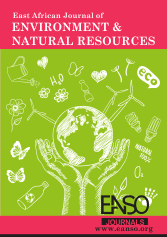Effects of Stone Mining on Household Livelihoods in Londiani Sub-County
Ikisiri
Globally, rural areas are dominated by households earning less than a dollar per day and engaging in subsistence agriculture to meet their basic needs. In Kenya, governments and non-governmental organizations have taken measures to promote agricultural activities and non-agricultural activities to alleviate poverty in rural areas. One of such none agricultural activity in Kenya is stone mining. Stone mining is an alternative source of livelihood for most rural households. The objective of the study was to establishment the effects of stone mining on household livelihoods in the Londiani, Sub-County. Primary data was collected by use of structured household questionnaires and Key Informant Interviews. Descriptive statistics was used during data analysis where percentages were computed and tabulated. The study revealed that: stone quarry activities have adverse effects on residents of Londiani sub-County, notably: respiratory diseases, chest and skin infections, eye problems, rashes, and body injuries. Stone mining has numerous benefits to the miners' livelihoods. The money generated from stone mining is used to pay school fees, purchase food for the family, clothing, and health services and even build shelter for the family. The study recommends for an audit of the number of households directly involved in quarrying activities with a view to extending credit facilities to boost mining sector. The findings are significant to policymakers in the county government of Kericho, and national governments in formulating policies aimed at streamlining informal sectors into mainstream economic activities
Upakuaji
Marejeleo
Aigbedion, I.N. (2005) Environmental Pollution in the Niger-Delta, Nigeria. Inter-Discplinary Journal of Enugu-Nigeria, 3, 205-210.
Banez, J., Ajon, S. M., Bilolo, J. R., & Dailyn, J. M. (2010). Report on Quarrying and its environmental effects. UN Journal, 10.
Chigonda, T. (2010). An analysis of benefits and costs of black granite quarrying in Mutoko district, Zimbabwe: A socio-cultural, bio-physical approach. Journal of Sustainable Development in Africa, 12(3), 324–337.
Department for International Development (DFID). (1999). Sustainable Livelihood Guidance Sheets. Accessed August 2021.http://www.livelihoods.org/info/info_guidanceSheets.html Discussion (1997).
Dong-dong, Z., Yu-shan, S., & Le, L. (2009). Study on sustainable landscape design of abandoned quarries: An example: Zhushan ecological park in Xuzhou. Procedia Earth and Planetary Science, 1(1), 1107-1113.
Gale, A.N. and Groat, C.G. (2001), Potential Environmental Impacts of Quarrying Stone in Karst. U.S. Geological Survey (HTTP
Hentschel, T., Felix H. and Michael P. (2003) Global report on artisanal and small-scale mining, IIED and WBCSD
International Fund for Agricultural Development (IFAD). (2001).Rural Poverty Report 2001 - The Challenge of Ending Rural Poverty.New York Oxford University Press. http://www.naturalresources.org/minerals/cd/docs/ilo/TMSSM_1999.
International Fund for Agricultural Development (IFAD). (2006). Rural Poverty Portal www.ruralpovertyportal.
Kitula, A. G. N. (2006). The environmental and socio-economic impacts of mining on local livelihoods in Tanzania: A case study of Geita District. Journal of cleaner production, 14(3-4), 405-414.
Ngure, J. N., Kihoro, J. M., &Waititu, A. (2015). Principal component and principal axis factoring of factors associated with high population in urban areas: A case study of Juja and Thika, Kenya. American Journal of Theoretical and Applied Statistics, 4(4), 258-263.
Nwibo, A. N., Ugwuja, E. I., Nwambeke, N. O., Emelumadu, O. F., &Ogbonnaya, L. U. (2012). Pulmonary problems among quarry workers of stone crushing industrial site at Umuoghara, Ebonyi State, Nigeria. The international journal of occupational and environmental medicine, 3(4), 178–185.
SIDA. (2004). Strategic Guidelines for SIDA Support to Market-Based Rural Poverty Reduction. Improving Income among Rural Poor. Department of Natural Resources and the Environment: Stockholm, Sweden
Smith, R.D. (2001). Rural non-farm Economy. N.R.I. Report No 2657 NRI. DFID, W.B
Lad, R. J., &Samant, J. S. (2014). Environmental and social impacts of stone quarrying-A case study of Kolhapur District. International Journal of Current Research, 6(63), 5664-5669.
Wells, J. (2000). Environmental concerns and responses in small-scale stone quarries in Nairobi. Enterprise development & microfinance, 11(2), 28-38.
Copyright (c) 2024 Rono Samwel Kibet, Amon Mwangi Karanja, PhD

This work is licensed under a Creative Commons Attribution 4.0 International License.




























